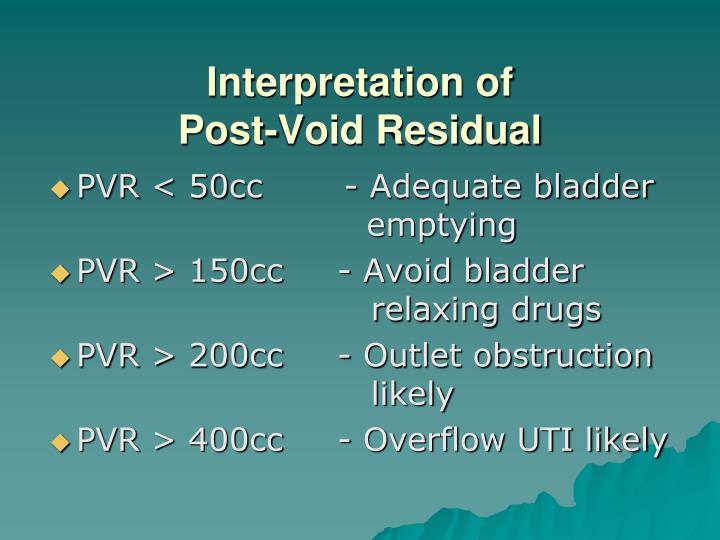
- Post void residual icd 9 how to#
- Post void residual icd 9 software#
- Post void residual icd 9 code#
- Post void residual icd 9 series#
Post void residual icd 9 series#
Use the new 200 series codes (200.30-202.78) for marginal zone, mantle cell, primary central nervous system, anaplastic large cell and peripheral T cell lymphoma. The CMS has created 54 new lymphoma codes that are more specific about the type of lymphoma and which lymph nodes are involved.
Post void residual icd 9 code#
The CMS is deleting the diagnosis code 787.2: Dysphagia for fiscal year 2008.

V17.49: Family history of other cardiovascular diseases.V17.41: Family history of sudden cardiac death.V12.54: Personal history of transient ischemic attack (TIA)Īnd cerebral infarction without residual deficits.V12.53: Personal history of sudden cardiac arrest.The CMS is introducing the following new V codes for personal and family history of cardiac arrest and TIA: The new code is: 789.59: Other ascites.Ĭardiovascular and transient ischemic attack (TIA) Instead, physicians should use a new code requiring a “9” as the fifth digit. 1, the diagnosis code 789.5: Ascites is defunct. A complete list of all new, revised and deleted codes is online.Įffective Oct. Here’s a look at the latest code changes that pertain to hospitalists. Otherwise, you can expect delays “or even denials “in reimbursement for your services after Oct.
Post void residual icd 9 software#
Be sure your charge documents and billing software are in the process of being updated, and familiarize yourself with the code changes. 1: Sixteen codes were deleted and should no longer be used (see “ Revised and deleted ICD-9 codes“), while the description for five codes was revised. 1 and beyond, with no grace period allowed for implementation. The not-so-good news? You must use the new (and revised) codes for services dated Oct. The good news? Most of those additions bring more specificity to diagnosis codes. 1, physicians will have 144 new ICD-9 codes to contend with, in addition to already existing ICD-9 codes. The deadline for using the new and revised ICD-9 codes is fast approaching.

This article outlines the advantages of ultrasound scanning over catheterisation, and gives an overview of the indications and contraindications of the procedure.Ĭitation: Yates A (2016) Using ultrasound to detect post-void residual urine. Nursing Times 112: 32/33/34, 16-19.Īuthor: Ann Yates is director of continence services, Cardiff and Vale University Health Board, Cardiff.Published in the September 2007 issue of Today’s Hospitalist Health professionals must be trained in who is, and is not, suitable for the procedure, how it should be carried out safely and interpreting the results so appropriate treatment can be planned. Ultrasound bladder scanning is increasingly used to detect post-void residual urine but is not suitable for everyone.
Post void residual icd 9 how to#
Ultrasound scanning can be used to detect post-void residual urine, but health professionals need training in the benefits and risks, and how to perform itĪ wide range of people may experience urinary retention, which can result in other health problems.


 0 kommentar(er)
0 kommentar(er)
